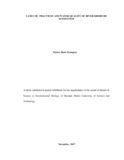LAND USE PRACTICES AND WATER QUALITY OF RIVER SHIMICHE ECOSYSTEM
Abstract
A majority of inland water bodies are rapidly undergoing degradation and drying up mainly due to human influences and climate change. These water bodies and especially those that supply domestic water to human populations should be given more attention for management and conservation. The main objective of the study was to determine the difference in water quality in relation to land use practices along River Shimiche in Western Kenya. The River’s ecosystem drains three land use types; forested environment in the upper course, sugarcane plantations and urban settlement in the middle and small-scale mixed farming activities in the lower course. Sampling was done at each sampling station on the first day of each month from January 2014 to August 2014. The sampling stations were selected to represent the mainland uses along the course of the river determined by direct surveys and observations. Water temperature, pH, electrical conductivity and total dissolved solids were measured in-situ in triplicate, using appropriate meters. Three water samples were randomly collected at each station and taken to the laboratory for determination of total suspended solids and concentration of Escherichia coli, a coliform bacterium. Water temperature were generally low in the forest area upstream with a mean of 21.08 °C, increased to 23.18 °C in middle stream with urban settlements, and further to 24.71 °C in area of mixed small scale farming downstream. pH, Total dissolved solids, conductivity, total suspended solids and turbidity followed a similar pattern: low values in the upper stream, increased in the middle stream and increased further in area with mixed small scale farming downstream. pH values ranged from 6.44 to 7.81, TDS (25.92 – 48.81 mg l-1) and turbidity (187.5-366.37 NTU). Concentration E. coli ranged from 12.97/100 ml to 178.97/100 ml, with no particular trends but higher values downstream. Statistical analyses were done using Statistical Analysis System (SAS) version 9.1. Mean, variance and standard error were used to assess the spread of the data. The mean parameters and one-way analysis of variance (ANOVA) were calculated to compare the mean values of observations based on land use. Where ANOVA showed significant differences, the means were separated through difference of the least square analysis. Pearson correlation co-efficient explored the relationships between physico-chemical parameters and E. coli concentrations in the three land use zones. The mean values of all the physico-chemical variables at the three land uses were significantly different (p<0.05); indicating that land use variation impacts on physical-chemical conditions in the river’s ecosystem. Mixed agriculture and urban settlements areas recorded the highest concentration of E coli. Changes in riparian land uses in the watershed therefore influence the river physico-chemical conditions, which subsequently affect concentration of E. coli, a biological indicator of water quality. There is need for the establishment of effective land management schemes by different stakeholders for sustainable utilization of land along the course of River Shimiche and other similar rivers.
Collections
- School of Education [70]

